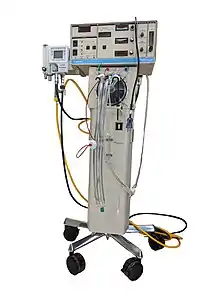
The SensorMedics High-Frequency Oscillatory Ventilator is a patented high-frequency (>150 Rf) mechanical ventilator designed and manufactured by SensorMedics Corp. of Yorba Linda, California. After a series of acquisitions, Vyaire Medical, Inc. marketed the product as 3100A/B HFOV Ventilators.[1] Model 3100 (later 3100A) received premarket approval from the United States Food and Drug Administration (FDA) in 1991 for treatment of all forms of respiratory failure in neonatal patients.[2] In 1995, it received pre-market approved for Pediatric Application with no upper weight limit for treating selected patients failing on conventional ventilation.
3100A
The 3100A model is used for infants and children under 35 kilograms (<35 kg).[3]
3100B
The 3100B model is used for all other people weighing more than 35 kilograms.[3]
Controls and settings
Bias flow
Adjusting bias flow affects mean Paw. Lowering bias flow may decrease the work of breathing and facilitate weaning.
- Typical ranges
- Premature 8–15 LPM
- Near-term 10–20 LPM
- Small child 15–25 LPM
- Large Child 20–30 LPM
Adjust
This control sets the mean airway pressure, directly affecting lung volume and oxygenation.
The initial setting is slightly higher than the mean airway pressure for conventional ventilation.
Power
Piston displacement is controlled by the power setting. Power changes ventilation and thereby changes blood PaCO2 levels.
- Typical values
Start with a power of 2.0 and adjust for chest wiggle to the umbilicus.
Inspiratory time %
Ti% is the percentage of time allotted for inspiration. Once this value is set, it rarely needs to be changed.
- Typical values
- 33% is recommended by the manufacturer for almost all applications.
- Up to 50% is recommended in situations where lung recruitment is necessary.
- Any Inspiratory Time above 33% can cause air trapping and lead to barotrauma. Setting the Mean airway pressure 1–2 cm of h2O above the set MAP for a few minutes, then weaning back down to the original MAP can recruit alveoli safely.
Frequency
Frequency (Rf) is the number of breaths in one second, expressed in hertz (hz). One hertz is equal to 60 breaths per minute (Rf) .
- Typical values and ranges
- The smaller the patient, the higher the frequency.
- The larger the patient, the lower the frequency.
- Changes in frequency
- Decrease in frequency = increased tidal volume.
- Increase in frequency = decreased tidal volume.
Problems
Since neither the 3100A or the 3100B measure actual tidal volumes, it is impossible to wean with precision;[4] as a result, some clinicians find it problematic to use these machines for oscillatory ventilation.[4]
References
- ↑ "3100A/B HFOV Ventilators". Vyaire Medical. Retrieved 6 July 2020.
- ↑ "Premarket Approval (PMA)". www.accessdata.fda.gov. Retrieved 6 July 2020.
- 1 2 Custer JW, Ahmed A, Kaczka DW, Mulreany DG, Hager DN, Simon BA, et al. (2011). "In vitro performance comparison of the Sensormedics 3100A and B high-frequency oscillatory ventilators". Pediatric Critical Care Medicine. 12 (4): e176–80. doi:10.1097/PCC.0b013e3181fe3028. PMID 21037502. S2CID 205929354.
- 1 2 Scott CJ, McGeorge AD, Hancock SW (1997). "Failure of adequate ventilation using Sensormedics 3100A High Frequency Oscillatory Ventilator". Paediatr Anaesth. 7 (5): 432. PMID 9308072.